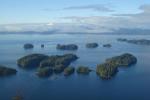
Old-growth tree in Tongass temperate rainforest. Such trees may be as old as 800 years. Photo by: John Schoen.
Up to 17 percent of the tallest old-growth trees in the Tongass temperate rainforest could be cut under new U.S. legislation, according to a report by Audubon Alaska. The report argues that the legislation under consideration (S 730 and HR 1408) would resurrect the banned practice of “high-grading,” which allows loggers to select the largest, most-ancient trees across the forest for cutting despite their ecological importance. The legislation is a part of a controversial 65,000 acre logging concession in Tongass to Sealaska Corporation, which is owned by 20,000 members of Native communities, from the Tlingit, Haida and Tsimshian tribes.
“Congress recognized the problem of high-grading on the Tongass and took action to ban the practice in 1990,” said Matt Kirchhoff, Audubon Alaska’s director of bird conservation and co-author of the report, in a press release. “The legislation now being sought by Sealaska Corporation would not only return to ‘high-grading’ of the biggest and rarest trees on the Tongass, it would effectively mandate it.”
Under the legislation, put forward by Alaskan Senator Lisa Murkowski and local Representative Don Young (both Republicans) Sealaska could target trees in volume class seven, i.e. the oldest and tallest trees in the rainforest, with impunity. In fact the bills allowed Sealaska to select outside designated boxes for logging, including over 12,000 acres of the biggest trees in the Tongass. Many of the trees in this size have already been lost to historic logging, making such stands, often between 300 and 800 years old, exceedingly rare. Research has shown that old-growth forests are the most biodiverse and sequester the most carbon.
“The remaining stands of very large-tree old growth, the stands of really big trees, are extremely rare and account for only one-half of one percent of the 16.8 million-acre Tongass,” explains Eric Myers, Audubon Alaska’s director of policy and report co-author.
Sealaska Executive Vice President Rick Harris, however, told the Associated Press that the Audubon report mischaracterized the legislation, and that Sealaska was working to avoid logging in sensitive areas.
The logging concession is an extension of the 1971 Alaska Native Claims Settlement Act that compensated native tribes in the area for lost lands. For Sealaska, the concessions in Tongass would represent the last commitment to the company. However, critics say the company has a long-time reputation for clearcutting forests and selling the logs to Asia—to fetch a higher price—versus employing local mills and using sustainable logging practice. Sealaska is the largest landowner in Southeast Alaska, owning over 290,000 acres of land before the Tongass concession.
Related articles

(07/11/2010) Most of the US’s large ecosystems are but shadows of their former selves. The old-growth deciduous forests that once covered nearly all of the east and mid-west continental US are gone, reduced to a few fragmented patches that are still being lost. The tall grassy plains that once stretched further than any eye could see have been almost wholly replaced by agriculture and increasing suburbs. Habitats, from deserts to western forests, are largely carved by roads and under heavy impact from resource exploitation to invasive species. Coastal marine systems, once super abundant, have partially collapsed in many places due to overfishing, as well as pollution and development. Despite this, there are still places in the US where the ‘wild’ in wilderness remains largely true, and one of those is the Tongass temperate rainforest of Southeast Alaska.
Local voices: frustration growing over Senate plan on Tongass logging
(06/17/2010) Recently local Alaskan communities were leaked a new draft of a plan to log 80,000 acres of the Tongass forest making its way through the US Senate Energy and Natural Resources committee. According to locals who wrote to mongabay.com, the draft reinforced their belief that the selection of which forests to get the axe has nothing to do with community or environmental concerns.
Photos: Tongass logging proposal ‘fatally flawed’ according to Alaskan biologist

(06/15/2010) A state biologist has labeled a logging proposal to hand over 80,000 acres of the Tongass temperate rainforest to Sealaska, a company with a poor environmental record, ‘fatally flawed’. In a letter obtained by mongabay.com, Jack Gustafson, who worked for over 17 years as a biologist with the Alaska Department of Fish and Game, argues that the bill will be destructive both to the environment and local economy.
Locals plead for Tongass rainforest to be spared from Native-owned logging corporation

(04/29/2010) The Tongass temperate rainforest in Alaska is a record-holder: while the oldest and largest National Forest in the United States (spanning nearly 17 million acres), it is even more notably the world’s largest temperate rainforest. Yet since the 1960s this unique ecosystem has suffered large-scale clearcutting through US government grants to logging corporations. While the clearcutting has slowed to a trickle since its heyday, a new bill put forward by Senator Lisa Murkowski (Rep.) gives 85,000 acres to Native-owned corporation Sealaska, raising hackles among environmentalists and locals who are dependent on the forests for resources and tourism.














